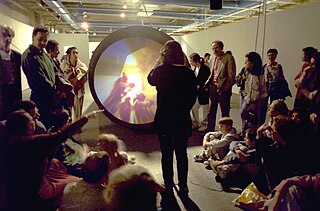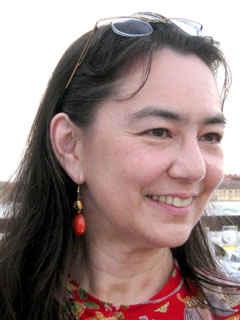Related Research Articles

SIGGRAPH is an annual conference centered around computer graphics organized by ACM, starting in 1974. The main conference is held in North America; SIGGRAPH Asia, a second conference held annually, has been held since 2008 in countries throughout Asia.

Interactive art is a form of art that involves the spectator in a way that allows the art to achieve its purpose. Some interactive art installations achieve this by letting the observer walk through, over or around them; others ask the artist or the spectators to become part of the artwork in some way.

Manfred Mohr is a German artist considered to be a pioneer in the field of digital art. He has lived and worked in New York since 1981.
The Prix Ars Electronica is one of the best known and longest running yearly prizes in the field of electronic and interactive art, computer animation, digital culture and music. It has been awarded since 1987 by Ars Electronica.

Karl Sims is a computer graphics artist and researcher, who is best known for using particle systems and artificial life in computer animation.

ACM SIGGRAPH is the international Association for Computing Machinery's Special Interest Group on Computer Graphics and Interactive Techniques based in New York. It was founded in 1969 by Andy van Dam.

Rebecca Allen is an internationally recognized digital artist inspired by the aesthetics of motion, the study of perception and behavior and the potential of advanced technology. Her artwork, which spans four decades and takes the form of experimental video, large-scale performances, live simulations and virtual and augmented reality art installations, addresses issues of gender, identity and what it means to be human as technology redefines our sense of reality.
New media art journals are academic journals covering the topic of new media art. They can be published in physical or online format and typically include original research, interviews, and information about books, events and exhibitions that incorporate technology in the arts.

Maurice Benayoun is a French new-media artist, curator, and theorist based in Paris and Hong Kong.
Can You See Me Now? (CYSMN) is an urban chase game developed by Blast Theory and The Mixed Reality Lab in 2001. CYSMN is a pervasive game, where performers on the streets of a city use handheld computers, GPS and walkie talkies to chase online players who move their avatars through a virtual model of the same town. CYSMN was built in the Equator project on the EQUIP architecture.
Sachiko Kodama is a Japanese artist. She is best known for her artwork using ferrofluid, a dark colloidal suspension of magnetic nano-particles dispersed in solution which remains strongly magnetic in its fluid. By controlling the fluid with a magnetic field, it is formed to create complex 3-dimensional shapes as a "liquid sculpture".

Oliver Bimber is a German computer scientist. He is professor for computer graphics at the Johannes Kepler University Linz, Austria where he heads the Institute of Computer Graphics.

Tamiko Thiel is an American artist, known for her digital art. Her work often explores "the interplay of place, space, the body and cultural identity," and uses augmented reality (AR) as her platform. Thiel is based in Munich, Germany.

Ars Electronica Linz GmbH is an Austrian cultural, educational and scientific institute active in the field of new media art, founded in Linz in 1979. It is based at the Ars Electronica Center (AEC), which houses the Museum of the Future, in the city of Linz. Ars Electronica's activities focus on the interlinkages between art, technology and society. It runs an annual festival, and manages a multidisciplinary media arts R&D facility known as the Futurelab. It also confers the Prix Ars Electronica awards.

José Luis Moreira da Encarnação is a Portuguese computer scientist, Professor Emeritus at the Department of Computer Science of the Technische Universität Darmstadt in Germany and a senior technology and innovation advisor to governments, multinational companies, research institutions and organizations, and foundations. He is involved in the development of research agendas and innovation strategies for socio-economic development with a focus on emerging economies. He is also a member of the Topical Network Information and Communication Technology (ICT) and ICT-related activities of the German National Academy of Science and Engineering (acatech) and the German Berlin-Brandenburg Academy of Sciences and Humanities (BBAW). He is an elected member of the ACM SIGGRAPH Academy (USA).
Media art history is an interdisciplinary field of research that explores the current developments as well as the history and genealogy of new media art, digital art, and electronic art. On the one hand, media art histories addresses the contemporary interplay of art, technology, and science. On the other, it aims to reveal the historical relationships and aspects of the ‘afterlife’ in new media art by means of a historical comparative approach. This strand of research encompasses questions of the history of media and perception, of so-called archetypes, as well as those of iconography and the history of ideas. Moreover, one of the main agendas of media art histories is to point out the role of digital technologies for contemporary, post-industrial societies and to counteract the marginalization of according art practices and art objects: ″Digital technology has fundamentally changed the way art is made. Over the last forty years, media art has become a significant part of our networked information society. Although there are well-attended international festivals, collaborative research projects, exhibitions and database documentation resources, media art research is still marginal in universities, museums and archives. It remains largely under-resourced in our core cultural institutions.″
Naoko Tosa is a Japanese media artist based in Fukuoka, Japan. In recent years Tosa has been creating artwork expressing Japanese tradition and culture without utilizing digital technology but rather by taking photographic captures of water and flowers in motion at 2000 frames per second. Much of her focus is based on Japanese Zen, Shinto and Rinpa traditions. Rinpa, a school of painting which traces its origins to 17th century Kyoto emphasizes natural subjects, refinement and the use of gold leaf, and is a key influence in Tosa's most recent works.

Michael Kass is an American computer scientist best known for his work in computer graphics and computer vision. He has won an Academy Award and the SIGGRAPH Computer Graphics Achievement Award and is an ACM Fellow.

Eku Wand is a German Designer and Multimedia director. Wand is a professor of media design and multimedia at the Braunschweig University of Art with a research focus on Interactive Storytelling.
Monika Fleischmann and Wolfgang Strauss are renowned German new media artists. Since the mid-1980s, they have been instrumental in bridging the gap between new media art, computer science and knowledge art. Internationally recognized for their work in interactive environments, virtual reality (VR), mixed reality (MR), and knowledge discovery (KD), they are considered pioneers in new media art, community building and integrating transdisciplinary practices.
References
- ↑ Cubitt, Sean; Malina, Roger F. (2003). Women, Art, and Technology. Judy Malloy, 2003 MIT Press. ISBN 9780262134248. Comment by Sean Cubitt, Roger F. Malina. MIT Press. ISBN 9780262134248 . Retrieved 21 July 2019.
- ↑ "2018 Lifetime Achievement Award in Digital Art: Monika Fleischmann". SIGGRAPH 2018. Retrieved 21 July 2019.
- ↑ "Monika Fleischmann | ZKM". zkm.de. Retrieved 25 August 2023.
- 1 2 Fleischmann, Monika. "Research Gate". Research Gate.
- 1 2 "The self, the world and dissolving distinctions". @GI_weltweit (in Dutch). Retrieved 25 August 2023.
- ↑ digitalmedia-bremen.de, digitalmedia-bremen.de. http://www.hs-bremen.de/internet/de/studium/stg/dmb/ "digitalmedia-bremen.de".
{{cite web}}: Check|url=value (help) - ↑ "Prix Ars Electronica 1992, Interactive Art, GOLDEN NICA, Home of the Brain, Monika Fleischmann, Wolfgang Strauss". 90.146.8.18 Archive Prix Ars Electronica . Retrieved 21 July 2019.
- ↑ "Fleischmann, Monika; Strauss, Wolfgang: Home of the Brain". medienkunstnetz.de. Retrieved 21 July 2019.
- ↑ "ACM SIGGRAPH 2018 Award Winners". SIGGRAPH 2018. Retrieved 1 April 2019.
- ↑ "SIGGRAPH 2018 Spotlights Women in Computer Graphics". SIGGRAPH 2018. Retrieved 1 April 2019.
- ↑ "ARS Electronica ARCHIVE". 90.146.8.18. Retrieved 1 April 2019.
- ↑ "Monika Fleischmann, Wolfgang Strauss, Christian A. Bohn: Liquid Views". ACM SIGGRAPH ART SHOW ARCHIVES. Retrieved 2 April 2019.
- ↑ Archive, Asia Art. "ARTEC '97". aaa.org.hk. Retrieved 2 April 2019.
- ↑ "Monika Fleischmann, Wolfgang Strauss, Christian A. Bohn: Liquid Views – Rigid Waves". ACM SIGGRAPH ART SHOW ARCHIVES. Retrieved 2 April 2019.
- ↑ Strauss, Wolfgang; Fleischmann, Monika; Denzinger, Jochen; Groenegress, Christoph; Li, Yinlin (1 July 2003). "Information Jukebox – A semi-public device for presenting multimedia information content". Personal and Ubiquitous Computing. 7 (3): 217–220. doi:10.1007/s00779-003-0219-x. ISSN 1617-4909. S2CID 10013990.
- ↑ Ziegler, Jürgen; Szwillus, Gerd (12 March 2013). Mensch & Computer 2003: Interaktion in Bewegung (in German). Springer-Verlag. ISBN 9783322800589.
- ↑ "Proceedings of CAST01/Living in Mixed Realities, Conference on Artistic, Cultural and Scientific Aspects of Experimental Media Spaces". The Interaction Design Foundation. Retrieved 2 April 2019.
- ↑ "CSDL | IEEE Computer Society". www.computer.org. Retrieved 2 April 2019.